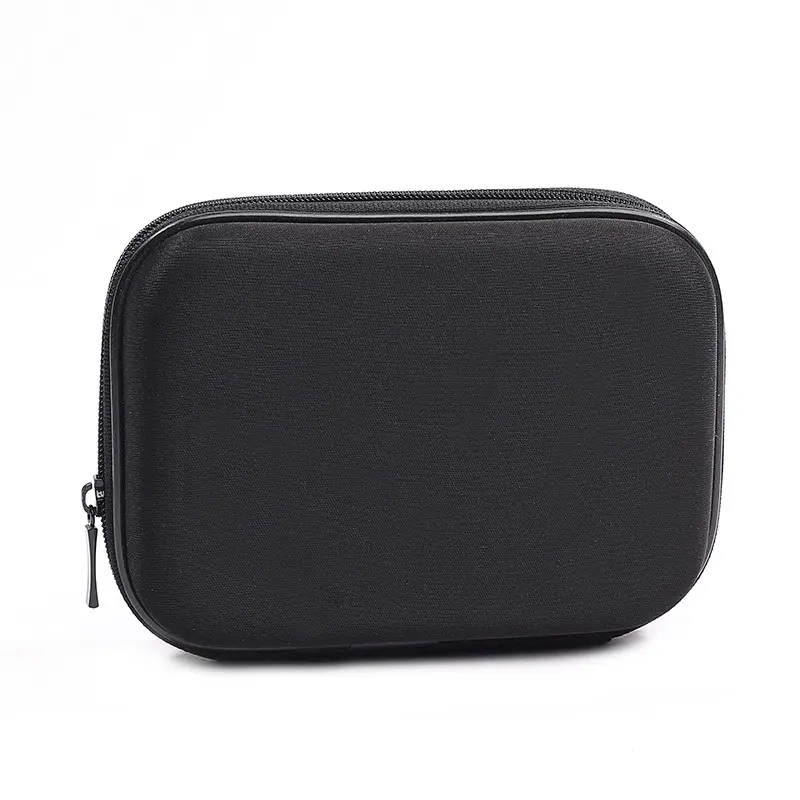Sealing Design of Waterproof EVA Tool Bags
In scenarios like outdoor work, electronics repair, and medical equipment transportation, “wet tools” are a frequent pain point for professionals. This can lead to short circuits in precision instruments, rust on metal fittings, and mold on paper documents. A single accidental water leak can directly result in losses of hundreds or even thousands of yuan. The core competitiveness of waterproof EVA tool bags lies precisely in their “invisible line of defense”—sealing. This design is not only a fusion of materials and craftsmanship, but also a comprehensive response to the need for “full lifecycle tool protection.” This article will examine the core logic of sealing design, key components, field-tested performance, and application-specific features to explain how waterproof EVA tool bags achieve “waterproofness.”
I. The Core Logic of Sealing Design: Dual Protection from “Water Blocking” to “Water Locking”
The sealing design of waterproof EVA tool bags doesn’t rely solely on the inherent water resistance of the EVA material. Instead, it integrates “material properties + structural design” to create a comprehensive protection system from the surface to the interior. The core logic can be summarized in two points:
Basic Water-Repellent Layer: The inherent advantage of the EVA substrate. EVA (ethylene-vinyl acetate copolymer) has a dense molecular structure that is impermeable and non-water-absorbing at room temperature, effectively blocking the penetration of most liquid water. Some high-end products also apply a “water-repellent treatment” (such as a PTFE coating) to the EVA surface to further enhance its hydrophobicity, allowing water droplets to quickly slide off upon contact and minimize their residence time.
Critical Water-Locking Layer: The Precision Sealing Structure. EVA alone cannot solve the problem of “interface gaps”—the opening and closing of a tool bag, zippers, and corner seams are all vulnerable points for water seepage. The core of sealing design is to “lock” these gaps through specialized structures. Common strategies include:
Extrusion sealing: The elastic deformation of the sealing strip fills the gap when closed (similar to the principle of refrigerator door seals);
Labyrinth sealing: A multi-layered folding structure extends the water penetration path and reduces the likelihood of water seepage;
Welding sealing: Heat-pressed welding is used for corner seams, replacing traditional stitching (which can leave pinholes and allow water to seep in).
II. Three Key Components of Sealing Design: The “Hard-Core Details” That Determine Waterproof Performance
If the core strategy is the “design concept,” then the key components are the “implementation guarantee.” The sealing performance of a waterproof EVA tool bag is primarily determined by the following three components, which are also the core criteria when purchasing:
1. Waterproof zipper: The “first gate” at the opening and closing point
Ordinary zippers have gaps between the teeth, allowing water to easily seep through these gaps. Waterproof zippers address this issue through two design methods:
Coated waterproof zippers: A waterproof coating (such as PVC or TPU) is sprayed onto the chain elements and tape, reducing gaps and enhancing water repellency.
Tapered waterproof zippers: An elastic strip is attached to the inside of the zipper. When closed, the strip is squeezed by the chain elements, completely sealing gaps. (This offers a higher waterproof rating and is commonly found on outdoor gear.)
Note: Waterproof zippers must be designed with a “pressure-resistant design”—sufficient pressure must be applied to the zipper area when the bag is closed to ensure the strip adheres. Some products feature a “Hook-and-loop” tape on the outside of the zipper for added security.
2. Sealing tape: A gap filler for corners and joints
Sealing tape is another core component, besides the zipper, and is primarily used to secure seams in tool bags (such as the connection between the flap and the bag body, and the seams of the side panels). High-quality sealing strips must meet two requirements:
Material: EPDM or TPU elastomer are preferred. These materials are resistant to high and low temperatures (-40°C to 80°C), age well, and maintain their elasticity after long-term use, preventing hardening or cracking and loss of sealing effectiveness.
Installation: Embedded injection molding is used to seamlessly bond the strips to the EVA substrate, preventing them from falling off (low-quality products often use glue, which can easily fall off when exposed to water or high temperatures).
3. Hot-pressed welded seams: A “hole-free” alternative to stitching. Traditional tool kits often use stitching, but pinholes can create channels for water seepage. Waterproof EVA tool kits commonly use hot-pressed welding for their seams:
Principle: High temperature and high pressure are used to melt the contacting surfaces of the EVA substrate. After cooling, a “one-piece” seam is formed, free of pinholes or gaps.
Advantages: Not only is the seam highly waterproof, but it also improves the tensile strength of the seam (traditional stitching relies on the strength of the thread, while hot-pressed welding relies on the strength of the substrate itself). The following table clearly compares the key components of traditional tool bags and waterproof EVA tool bags:
Component Traditional Tool Bag Waterproof EVA Tool Bag Core Advantages
Zipper Ordinary metal/nylon zipper Coated/adhesive waterproof zipper + Velcro tape Prevents water seepage through zipper gaps
Seams Sewn with cotton/nylon thread, heat-pressed welded + sealed with adhesive strips Pinhole-free, seamless
Edge Treatment Over-sewn, one-piece injection molding + adhesive strip wrap Prevents water seepage from abrasion
III. Field Test Verification of Sealing Design: Proving “True Waterproofness” with Data
Just saying “waterproof” is unconvincing; a professional waterproof EVA tool bag must be verified by authoritative testing standards. The following are three core tests commonly used in the industry and are crucial for demonstrating sealing performance to customers:
IPX Waterproof Rating Test (Most Commonly Used): The IPX rating is an internationally recognized waterproof standard. Waterproof EVA tool kits typically require IPX5 or IPX6 ratings:
IPX5: Withstands low-pressure water spray (12.5L/min, 3m distance) from any direction for 3 minutes without water seepage;
IPX6: Withstands high-pressure water spray (100L/min, 3m distance) from any direction for 3 minutes without water seepage.
Note: Some high-end products can achieve IPX7 (short-term immersion, 1m depth for 30 minutes without water seepage), making them suitable for use in submerged environments. Simulated scenario testing: In addition to standard testing, real-world scenarios must be simulated to meet actual usage needs. For example:
Outdoor rainstorm test: A tool bag containing electronic tools (such as a multimeter) is placed in a heavy rain environment (rainfall rate of 50 mm/h). After 2 hours, the interior is inspected for moisture.
Accidental drop test: A fully loaded tool bag is dropped from a height of 1.2 meters onto a concrete floor (zipper closed) to inspect for seal damage and water seepage.
High temperature and humidity test: The tool bag is placed in an environment of 40°C and 90% relative humidity for 72 hours to inspect for aging of the sealing strips and degradation of waterproofing.
Long-term durability testing: Avoiding “short-term waterproofing, long-term failure.”
The durability of the sealing design is equally important and requires verification through “cyclic testing”:
Zipper opening and closing cycles: The waterproof zipper is repeatedly opened and closed 500 times, with an IPX5 test performed after each opening and closing to ensure no degradation of waterproof performance.
Gland strip elasticity cycles: The sealing strip is repeatedly squeezed and released 1000 times, inspecting for permanent deformation or breakage.
IV. Scenario-specific adaptation of the sealing design: Different solutions for different needs
The sealing design of the waterproof EVA toolkit is not a one-size-fits-all solution; it must be tailored to the specific needs of the intended application. The following are adaptation solutions for three typical scenarios to help you more accurately position your product:
1. Outdoor work scenarios (such as power maintenance and landscaping)
Core requirements: Protection against heavy rain, mud and sand, and abrasion.
Sealing design highlights:
The zipper uses an IPX6-rated waterproof rubber strip, with a double-layer Velcro tape on the outside to prevent mud and sand from entering the zipper gap.
All seams on the bag are heat-welded, and wear-resistant rubber corner guards are added to the corners to prevent damage from impacts.
The bottom of the bag uses 2mm thickened EVA material to enhance puncture resistance and water resistance (to protect against surface water and sharp objects).
2. Electronic Equipment (e.g., mobile phone repair, precision instrument transport)
Core Requirements: Waterproof, dustproof, and anti-static;
Sealing Design Key Points:
A “labyrinth-style sealing structure” (foldable cover) ensures both waterproof (IPX5) and dustproof (IP54);
An anti-static lining is added to the interior to prevent static damage to electronic components;
A “silent waterproof zipper” is used to reduce friction noise during opening and closing (suitable for indoor precision operations).
3. Medical Emergency (e.g., outdoor first aid kits, portable medical equipment bags)
Core Requirements: Waterproof, antibacterial, and easy to clean;
Sealing Design Key Points:
The sealing strip is made of medical-grade EPDM (FDA-compliant), which is odorless and resists bacterial growth;
The antibacterial TPU coating on the bag surface allows for direct disinfection with alcohol wipes without compromising sealing performance;
A “quick-open/close sealing structure” (e.g., a push-button buckle + waterproof zipper) ensures both waterproofness and quick access in emergency situations.
5. How to Identify High-Quality Sealing Designs? 4 Practical Identification Methods
For buyers or end users, how can you quickly determine if a waterproof EVA tool bag has a high-quality seal? The following four methods are simple and easy to use:
Check the seams: Are they “pinhole-free and protrusion-free”? High-quality products should have smooth, hot-pressed welds with no visible stitching or pinholes. The sealing tape should be seamlessly bonded to the EVA substrate, with no peeling or bubbles (protrusions or gaps indicate water seepage).
Test the zipper: Is it “resistance-free and springy” when opening and closing? A waterproof zipper should have slight resistance when opening and closing (a feeling of the seal squeezing). Once closed, pull the zipper pull without feeling loose. If it opens and closes too smoothly, the seal may not be properly adhered, resulting in poor waterproofing.
Test the seal: A simple “water splash test” involves placing a dry paper towel inside the tool bag. Close the zipper and all buckles, then pour a small amount of water (simulating a light rain) on the zipper and seams. Leave it for 5 minutes, then open and inspect. If the paper towel is dry, the basic seal is satisfactory.
Check certification: Does it have an authoritative test report? Reputable manufacturers will provide IPX waterproof test reports (such as SGS or Intertek certifications). The report should clearly state the test level, time, and results. Be cautious when choosing products without these reports.
Conclusion: Sealed design is more than just waterproofing; it also provides peace of mind.
For waterproof EVA tool bags, sealing is never just an “add-on feature” but a core value. It’s the result of meticulous material selection, meticulous craftsmanship, and insight into application needs. From preventing even a drop of water from penetrating, to protecting tools and ensuring a smooth operation, sealing embodies the user’s expectation of reliability.
Post time: Oct-13-2025





